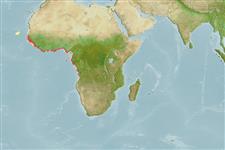Environment: milieu / climate zone / depth range / distribution range
Ökologie
seewasser; süßwasser; brackwasser demersal; tiefenbereich 0 - 50 m (Ref. 2683). Tropical; 21°N - 18°S, 26°W - 20°E
Eastern Atlantic: Senegal to Angola (Ref. 5979, 81290, 81683). Also reported from Mauritania (Ref. 55783).
Size / Gewicht / Alter
Maturity: Lm ? range ? - ? cm
Max length : 17.6 cm TL Männchen/unbestimmt; (Ref. 128374)
Rückenflossenstacheln (insgesamt): 0; Rückenflossenweichstrahlen (insgesamt): 80-87; Afterflossenstacheln 0; Afterflossenweichstrahlen: 59 - 65. Diagnosis: body oval, its depth 45-50% SL (Ref. 81290, 81683). Head length 27-31% SL; eye diameter 16-23% HL; teeth in a single row on upper as well as lower jaw, no caniniform teeth (Ref. 81683). Interorbital space narrow and slightly concave (Ref. 81290, 81683). Hind end of maxilla extending to below centre of eye (Ref. 81290, 81683) but never posterior to posterior edge of pupil (Ref. 81683). Fin base length of both pelvic fins short and of about equal length (Ref. 81683). Body covered with cycloid or weakly ctenoid scales (Ref. 81290, 81683). Gill rakers moderately long and slender (Ref. 81290, 81683), about 2/3-3/4 length of gill filaments at angle of gill arch (Ref. 81683).
Coloration: eyed side yellowish brown with dark spots along dorsal and anal fins; dark brown spot at base of caudal fin, as well as on upper and lower caudal fin rays; dorsal and anal fins with a series of dark brown spots; blind side entirely whitish (Ref. 81620, 81683).
Occurs in coastal waters (Ref. 2683, 81290) and brackish water of estuaries and lagoons (Ref. 81290, 81683), also ascending rivers (Ref. 81683) and entering freshwater (Ref. 2683). Feeds on fish, shrimps and crabs (Ref. 28587).
Life cycle and mating behavior
Geschlechtsreife | Fortpflanzung | Ablaichen | Eier | Fecundity | Larven
Distinct pairing (Ref. 205). Oviparous (Ref. 101737). Females produce numerous eggs in multiple spawnings during a prolonged spawning period (Ref. 101737).
Aldebert, Y., M. Desoutter and J.-C. Quéro, 1990. Bothidae. p. 1027-1036. In J.C. Quero, J.C. Hureau, C. Karrer, A. Post and L. Saldanha (eds.) Check-list of the fishes of the eastern tropical Atlantic (CLOFETA). JNICT, Lisbon; SEI, Paris; and UNESCO, Paris. Vol. 2. (Ref. 5979)
IUCN Rote Liste Status (Ref. 130435)
Bedrohung für Menschen
Harmless
Nutzung durch Menschen
Fischereien: kommerziell
Mehr Information
ReferenzenAquakulturAquakultur ProfilZuchtlinienGenetikElectrophoresesVererbbarkeitKrankheitenVerarbeitungNutrientsMass conversion
Tools
Zusatzinformationen
Download XML
Internet Quellen
Estimates based on models
Preferred temperature (Ref.
123201): 23.7 - 28, mean 26.7 °C (based on 66 cells).
Phylogenetic diversity index (Ref.
82804): PD
50 = 0.5000 [Uniqueness, from 0.5 = low to 2.0 = high].
Bayesian length-weight: a=0.00741 (0.00325 - 0.01693), b=3.15 (2.97 - 3.33), in cm total length, based on LWR estimates for this Genus-body shape (Ref.
93245).
Trophic level (Ref.
69278): 3.9 ±0.67 se; based on food items.
Widerstandsfähigkeit (Ref.
120179): hoch, Verdopplung der Population dauert weniger als 15 Monate. (Preliminary K or Fecundity.).
Fishing Vulnerability (Ref.
59153): Low vulnerability (10 of 100).
Nutrients (Ref.
124155): Calcium = 279 [133, 549] mg/100g; Iron = 1.31 [0.64, 2.52] mg/100g; Protein = 17.1 [15.0, 19.1] %; Omega3 = 0.167 [0.079, 0.343] g/100g; Selenium = 48.1 [21.8, 105.2] μg/100g; VitaminA = 15.6 [4.7, 57.4] μg/100g; Zinc = 1.36 [0.89, 2.02] mg/100g (wet weight);
